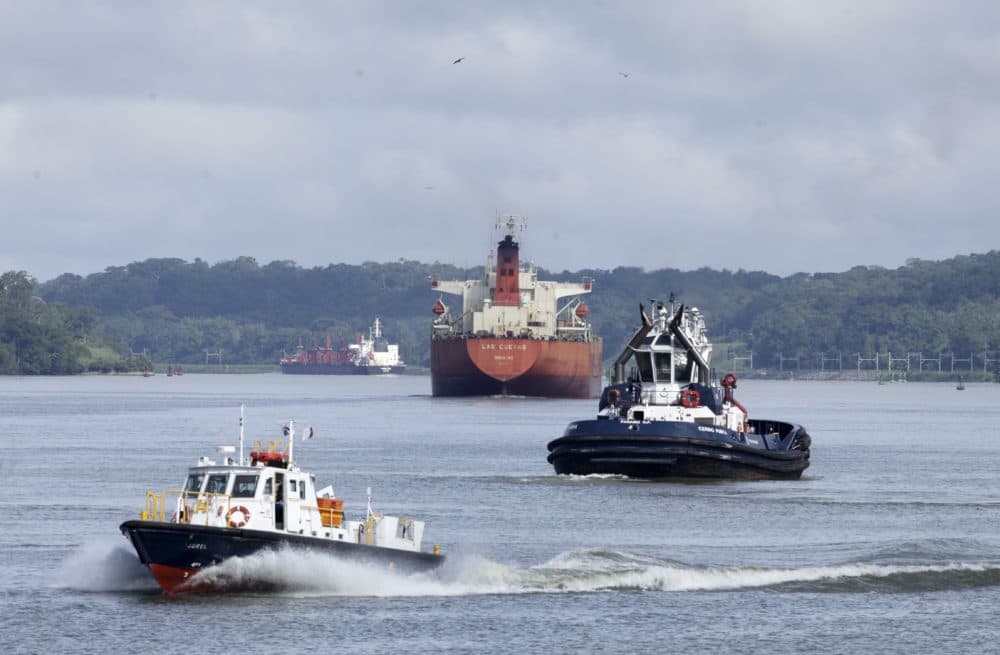Advertisement
View From The Top
Climate Change, COVID-19 Pandemic Threaten Future Of Panama Canal

More than 100 years after it opened, the Panama Canal still plays an important role in global trade — but the pandemic and climate change are threatening its business model.
The 50-mile long canal connects the Atlantic and Pacific Oceans, so ships can cut across Panama rather than travel all the way around the southern tip of South America. It shortens the journey by about 8,000 miles.
Since the coronavirus began to spread across the world, there has been a “very significant decline” in shipping through the canal, says Ricaurte Vasquez, administrator of the Panama Canal.
In January, up to 40 vessels per day traveled through the canal, he says. Now, only about 25 pass through each day.
Vasquez says that reduction comes from a lack of cruise ships, which have almost entirely halted operations amid the pandemic, and ships carrying automobiles, since manufacturing plants were also shut down.
The role of the Panama Canal in global trade is also expected to shift due to the COVID-19 pandemic, Vasquez says.
“You will try to reduce long supply chains into shorter supply chains that are closer to the destination markets and introduce a lot less risk of any other events similar to what we are experiencing this year,” he says. “That means that global trade is going to be replaced to some degree by regional trade.”
Compounding the impact of the pandemic, the canal is also running low on water due to climate change. Last year was one of the driest since the canal opened, with 20% less rainfall than the average year.
In order to conserve water, canal operators did something called “cross filing” the locks, which transfers the water laterally from one chamber of the canal to another, he says. A lock is a device that raises and lowers ships into different levels of a canal.
“That requires that we schedule vessels in such a way that when one vessel was going south, the other vessel was going north, and they met at the lock at the same time,” Vasquez says. “So scheduling was challenging.”
Advertisement
But when you recirculate water through the basins, Vasquez says it can increase the salinity in Gatun Lake, which is a freshwater source for Panamanians.
“So we have to use a very specific balance between saving water, with a lot less rainfall,” he says, “and then at the same time, keeping water quality at a point which could be used for human consumption.”
This year, the rainy season began in mid-May as expected, which helped raise the water level significantly, Vasquez says.
“So given that lower volume of traffic and the on-time start of the rainy season, our lake reached 82 feet of elevation last week,” he says, “something that last year we accomplished by the end of September.”
As warming global temperatures melt ice in the Arctic, scientists expect a new shipping lane to open up in the north. Vasquez says he’s not concerned about competition from the Arctic because it would take coordination between several countries to get the new waterway up and running.
“When you come through the Panama Canal, you are dealing with the Panama Canal and the Republic of Panama,” he says. “When you go in through the Arctic Circle, you are dealing with different countries, and it will take some effort for all of these countries to come to an agreement in how you use that route.”
Since the U.S. relinquished control of the canal to Panama in 1999, the percentage of global maritime trade handled by the waterway has dropped to about 3%.
Vasquez also expects trade through the canal to shift from manufactured goods to more commodities, such as wheat and oil, which means the canal will continue to maintain a role in global trade.
“For the U.S. market, the Panama Canal will remain very relevant,” he says, “and as long as the U.S. economy is the largest economy of the world, we will have a very important role to play in world trade.”
Julia Corcoran produced and edited this interview for broadcast with Peter O'Dowd. Samantha Raphelson adapted it for the web.
This segment aired on June 22, 2020.

